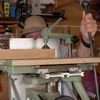This may interest any soul as simple as your informant. I recently applied Mr Gochnour’s excellent advice in sharpening a very old gent’s saw I had picked up in a sale. The teeth had all but disappeared so I topped the blade and filed new teeth every 1/16th inch. The blade is six inches long so after filing four inches I decided to see if my work would cut.
The strange thing is that not only do the filed teeth cut well, but by not filing teeth on the last two inches I am able to precisely place the cut and need hardly any clean up. I have now sharpened that last two inches as a marking knife. The teeth are too fine to give any set but have cut 1/2 inch beech. If you try it just start by marking and then run the teeth on the mark without lifting the saw.















Replies
I'm I correct in assuming that the unsharpened end is farthest from your hand when in use? Could you put up a picture?
Unfortunately my daughter has commandeered her digital camera for a few days whilst on holiday looking at horses. Yes, the knife end is furthest away from the handle. Thus, I do not have to draw the saw back to establish the kerf as formerly, the unset teeth enter the fine line without deviation.
I am computer inept but will play with the scanner later.
Sometimes photo-copying works on flat tools to get an image on paper, so I suppose scanning the saw blade could work too. I can however picture what you've done and it makes me wonder if it was ever done in the past.
I tried and produced a blurred image. Then found I do not have the faintest idea how to put that on to a knots message! A sad case, I can do it on word but am lost here.
I suppose it has been approached in the past since certain saws had teeth graded over the length of the blade. However I do not recall hearing or reading of teeth being subsituted by a kerf cutter in the same blade.
Thanks for your interest, life gets better by discussion. I have always thought the saw nib on some old saws was a tempering indicator from the days when that job would be done by hand and the main body would not be visible to the craftsman. Never seen it suggested though.
If you try it, go for a wider tooth spacing, unless you also have masochistic tendancies. It's a nightmare, but I did cut them from scratch.
If I am reading your description correctly, it might look something like this configuration which is on a Goodell MFG backsaw (made by Disston though) which I have.
The teeth have been horribly misfiled, but the unfiled section is on both front and back of this beast. Only back saw I have ever seen with this feature.
Eric in Cowtown
Well yes, except it looks that the user is not intended to use the untoothed parts of your saw. I am sure a lot of us would like to know if it is a special purpose saw, would you put it on the gen. disscussion board and let us find out? Thanks .
Are you in Fort Worth? It may be a collectable.
Edited 7/15/2006 4:36 am ET by mufti
If I am reading your description correctly, it might look something like this configuration which is on a Goodell MFG backsaw (made by Disston though) which I have.The teeth have been horribly misfiled, but the unfiled section is on both front and back of this beast. Only back saw I have ever seen with this feature.Mufti asked if this could be posted generally, so I did. Almost certainly the saw is collectable, even though the teeth are butchered , just due to the configuration, if not it's age. Clearly it was used in a mitre box, as the marks of the slides are visible as polished areas. Total blade height is 5 1/2"; OA length of blade is 28. There is the possibility that this feature was created by a long-dead owner, as the "unfiled" sections are just a tad less precise in flatness than one would expect from a saw mfgr. Anyway, this is the only example I've seen. As to whether it is valuable or a mere curiosity, who knows. It ain't one of the users round here. Eric in Cowtown (Calgary)
This forum post is now archived. Commenting has been disabled